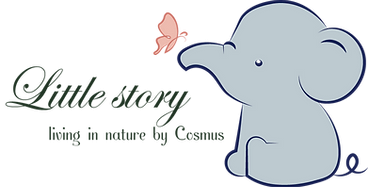Why your Child’s Organic journey should start now
Toxicity of synthetic fibres and Health – Everything you need to know
Nowadays, when we go shopping for garments, beddings, towels etc., we do not realise the toxic
and harmful nature of certain fabrics to our Child’s health. Neither do we think of its origin nor its
manufacturing process and the toxic load on our child’s body and on environment.
It is of great importance that we realise the harmful and dangerous effects of synthetic and semi-
synthetic fibres, especially when shopping for children as their skin is extremely vulnerable to the
exposure of harmful materials.
Let us give you a brief description of semi-synthetic and synthetic fabrics, so you get an idea of
how harmful it is not just for your child but for everyone.
Semi-synthetic materials
Rayon fibres are of vegetable origin and are derived from cellulose. They can be produced through
various processes
- Nitrocellulose process
- Cuprammonium process
- Viscose process
- Acetate rayon
The processing treatment can use several toxic chemicals. The combination of these chemicals can
linger on the clothing causing rayon wearers to suffer from nausea, vomiting, headache and chest
pain. More serious health issues include necrosis, anorexia, polyneuropathy, paralysis, insomnia and
Parkinson’s disease.
All Synthetic Fibres
All-synthetic fibres include Nylon, Polyester, Lycra and Spandex. These are used for wide variety of
apparels and are popular because they are thermoplastic, resilient, elastic and very strong.
Polyester
Polyester fibres are synthetic textile fibres formed by condensation polymerization of two
monomers: dicarboxylic acid or terephthalic acid and ethylene glycol. Both terephthalic acid and
ethylene glycol are known carcinogens.
These forms may enter the human body through skin. Phytoestrogens are emitted by polyester
which act as endocrine disrupters and also cause certain type of cancers. As the polyester fibre is
bad conductor of heat and sweat, it is responsible for acute skin rashes, redness, and itching. On
wearing for a long time, it can cause acute and chronic respiratory infections. Polyester is also
responsible for reproductive system disorders like reduced sperm counts.
Nylon
Nylon is also made by condensation polymerization. The petrochemicals used for polymerization of
nylon are non eco-friendly. Chemicals in the form of residues are retained by nylon fabric even after
complete manufacture. As nylon fibre is bad conductor of heat, it does not allow the sweat and body
heat to pass through. Formaldehyde in fabrics emitted by body heat causes skin allergies, eye
watering and is a known potent carcinogen also. Delustrant chemical (titanium oxide), barium
sulphate an antistatic substance cause hyper skin pigmentation, dermatitis and functioning of central
nervous system as disorientation, dizziness, headache and spine pain. Green house gases like
nitrous oxide and harmful volatile organic compounds are also emitted by nylon fabric.
Spandex
Due to use of the strong chemicals in the manufacturing process of spandex fibres, wearing these
fibres for long time, it can cause skin allergies. As the fibres don’t have the ability to absorb sweat,
once you start sweating beneath spandex, chemical could be released into the skin from the dyes
and formaldehyde used on the fabric which causes allergies. Contact dermatitis due to spandex is a
commonly seen side effect. Due to the inability of spandex to absorb sweat, skin can become fertile
ground for different bacterial infections. Folliculitis and impetigo is also fairly common & caused
due to long wear of spandex fibres.
Acrylic
DMF used in spinning process of acrylic fibres is easily absorbed through the skin and can cause
liver damage and other adverse health effects.
Side effects of the chemicals used in the textile fibre
manufacture. - Sulphuric acid
- Used in manufacturing process of rayon
- Can cause skin rashes, itching, redness, dermatitis,
necrosis and anorexia
- Carbon disulphide
- Emitted from rayon fabric
- Can cause nausea, headache, vomiting, chest and muscle
pain; and insomnia
- Nitric acid
- Used in rayon
- Can produce injuries to the skin, eye, respiratory and
gastrointestinal tract
- Ethylene glycol
- Used in manufacturing of polyester fibre
- It can cause dysrhythmias and heart failure
- Hexamethylene diamine
- Used in manufacturing of nylon fibre
- Can irritate skin, eyes, nose, throat and lungs; may also
damage the liver and kidneys, infertility in men
- Dimethyl formamide
- Used in spinning process of acrylic fibre
- Causes skin rashes and liver damage
- Formaldehyde
- Used in spandex, acrylic, nylon and polyester fibres
- Causes skin allergies and eye watering
- Barium sulphate
- Used as antistatic substance in the finishing of polyester,
nylon, spandex and acrylic fibres - Causes hyper skin pigmentation, dermatitis, dizziness,
headache and spine pain
- Terepthalic acid
- Used in manufacturing polyester fibre Carcinogenic
- Acrylonitrile
- It is used in manufacturing of acrylic fibre
- Carcinogenic and has bad effects on central nervous system
Now hear us out !
As we all know, children have delicate skin that are vulnerable to harmful exposure. While making
purchasing decisions, especially for your child, make sure you opt GOTS certified all organic cotton
brands, like ours (You can find the GOTS tag on the garment itself).
This will prevent your children from being exposed to any forms of illness caused by harmful
fabrics and at the same time be the most comfortable option for them.

